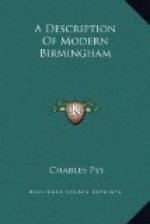Halesowen Abbey.
This ancient structure was situated about half a mile south of the town, on what is now called the manor farm, near the road leading to Northfield. King John, in the 16th year of his reign, granted a charter to Peter de Rupibus, bishop of Winton, by which he gave the manor and advowson of the church of Hales, with its chapels, to found a religious house in this place. In consequence of this grant, a convent of Praemonstratensians was established A.D. 1218, dedicated to the Virgin Mary and St. John the evangelist, and furnished with monks from the abbey of Welbeck, in Nottinghamshire. This religious order were canons, who lived according to the rule of St. Austin, and afterwards reformed by St. Norbet, at Praemonstre, in Picardy. They were called white canons, from their habit; which consisted of a white cossack, with a rotchet over it, a long white cloak, and a white cap. They continued under the jurisdiction of the abbot of Praemonstre, who received contributions from them, till the year 1512, when they were exempted by Pope Julius 2d. The churches and a large proportion of the tythes of Walsall, Wednesbury, Rushall, Clent, and Rowley, were granted to this convent, by successive monarchs, which was also richly endowed by opulent individuals. The abbot and convent held ten large farms in their own hands. In the reign of Henry 8th, the clear income amounted to L380 13s 2d. a large sum, considering the value of money in those days. In 1489, when the whole number of religious amounted only to seventeen, there were every week consumed in bread 20 bushels of wheat and rye. And in the course of the year, 1110 quarters of barley, 60 oxen, 40 sheep, 30 swine, and 24 calves; a proof that great hospitality and charity prevailed here at that time. The monastery consisted of an abbot, prior, sub-prior, sacrist, chanter, cellarer, and custos infirmorum: the monks never exceeded twenty in number.
At the visitations of their superiors, punishments if requisite were inflicted for immoralities. The house and church appear to have been stately edifices; the chancel, if not the whole of the choir, being paved with flat tiles, painted in a curious manner, some of them being now occasionally found; and the few ruins still extant cover an extensive plot of ground, exhibiting fine specimens of Saxon and Gothic architecture.




